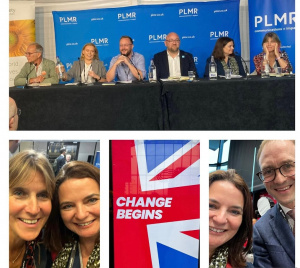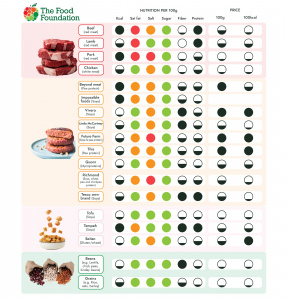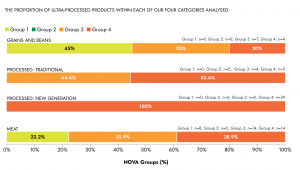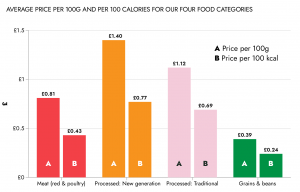
by Nutrilicious | Jul 24, 2025 | Retail, Hot Topics in nutrition, Thoughts, The Nation’s Health, Catering/Out of Home, Communications, Impactful health initiatives
At Nutrilicious, we believe that good nutrition should be accessible to everyone – especially during times of increased financial pressure. The summer holidays, while full of potential for family connection and rest, can be an incredibly stressful period for many households across the UK, particularly when it comes to putting food on the table.
For families already navigating tight budgets, the absence of free school meals and the need for more at-home meals and snacks significantly heightens food costs – and with it, food insecurity.
That’s why we’re proud to support the relaunch of the Iceland Food Club, a vital initiative from Iceland Foods in partnership with not-for-profit lender Fair for You, which provides interest-free loans of up to £75 to help families manage food spending over the summer break.
As part of our commitment to improving the nation’s nutrition, our sister company, MyNutriWeb, contributed nutrition expertise to this project – ensuring the solution is not only affordable but also nutritionally sound.
The Need Is Clear – and Urgent.
Recent research by Iceland Foods reveals the scale of the issue:
- 85% of parents report increased food bills over the summer
- This equates to a £553 million weekly increase in food spending across UK households
- The rise is driven by the need for more at-home food (73%) and the cost of extra snacks and drinks (68%)
With this in mind, the Iceland Food Club aims to provide practical and immediate relief.
What Is the Iceland Food Club?
Eligible families can access an interest-free loan of up to £75 loaded onto a pre-paid card for use in Iceland stores or The Food Warehouse. Repayable in £10 weekly installments, this initiative enables families to manage food costs without turning to high-interest options or sacrificing essentials.
Importantly, returning customers who’ve repaid their loan can top up to £100 during school holidays, helping ensure consistent access to nutritious meals.
“The summer holidays should be a time for families to relax and make memories, not worry about how they’re going to afford their next food shop… When we hear that nearly a quarter of parents are skipping meals so their children can eat, we know we have to step in.”
— Richard Walker, Executive Chairman, Iceland Foods
“The summer break is always one of the most financially stressful times of the year. With the rising cost of living, we’re expecting this to be our busiest period to date.”
— Simon Dukes, CEO, Fair for You
Our Role: Supporting Nutrition on a Budget
At Nutrilicious, we know that affordability should never mean compromising on nutrition. That’s why our expert dietetic team at MyNutriWeb proudly supported the creation of a budget-friendly shopping basket. Designed to stretch the £75 loan for maximum nutritional value, the shopping basket aligns with the UK Eatwell Guide and supports healthy, balanced meals.
This evidence-based basket is tailored for a family of two adults and two children under five, offering:
- 126 balanced portions including 5 breakfasts, 4 lunches, 5 dinners, and 7 snacks
- Recipes that are easy to prepare, affordable, and child-friendly (like banana pancakes, chilli sin carne, and chickpea wraps)
This is more than a collection of meals – it’s a tool for empowering families to shop and cook with confidence, even under financial stress.
“Working with Iceland Food Club to create this Eat Well-aligned basket is so important – it gives parents the means and confidence to buy fresh fruit, vegetables, and essentials available in Iceland supermarkets.”
— Tanya Haffner, CEO and Founder, MyNutriWeb
Why This Matters to Nutrilicious
We’re proud to be part of this initiative because it reflects everything Nutrilicious stands for – practical, impactful solutions that bridge the gap between food insecurity and good nutrition. The impact of food insecurity goes far beyond hunger; it affects mental health, children’s development, and family wellbeing.
How You Can Help
As part of our wider community of health professionals, communicators, and organisations, we encourage you to:
Small steps like sharing this initiative can make a real difference for families this summer.

by Nutrilicious | Jul 14, 2025 | Hot Topics in nutrition, Education
By Marta Buczkowska, Registered Dietitian

As the long-awaited NHS Plan is released, we took a moment – just ahead of publication – to ask ChatGPT for its predictions on what might be included. Some of those predictions made it into the final version, but others, disappointingly, did not. This comparison has helped highlight both the progress being made and the opportunities still to be seized.
In this blog, we unpack where the new NHS Plan gets it right, where it falls short, and what more is needed to truly move from treatment to prevention. Our analysis explores the latest commitments, what’s changing in policy and practice, and the crucial gaps that remain if we are to build a fairer, healthier, and more sustainable future
What’s next for the NHS? Moving from treatment to prevention – and where we go from here
The newly unveiled NHS Plan brings with it an increased focus on disease prevention and improving access to healthcare through shifting from analogue to digital and from hospital-based care to community centres. These changes reflect a growing recognition that reactive, hospital-centred treatment alone is no longer sustainable – we must address the root causes of ill health and make healthcare widely available to all.
While we welcome several positive steps outlined in the Plan, there remain key gaps that must be urgently addressed to create a truly equitable, sustainable and healthy society.
What’s continuing: positive momentum in policy
We’re encouraged by the government’s commitment to go ahead with restricting unhealthy food advertising to children. This move acknowledges the powerful role of familiarity in shaping dietary preferences from a young age. It’s one step in the right direction, but we urge policymakers to go further — extending advertising bans not only to public transport – like it’s already done in several areas of England which would further amplify the benefits, but to a blanket ban on advertising all HFSS foods like Norway. Similarly, updating the sugar tax to reflect inflation and extending it to all HFSS foods is a practical, evidence-based move that can further drive the decline in HFSS foods and beverages consumption.
What’s new – and what’s working
We welcome the broader recognition of the role of diet in preventing non-communicable diseases such as obesity, cardiovascular disease, and type 2 diabetes. Nutrition and lifestyle interventions must be at the centre of our prevention strategy, not an afterthought.
We applaud the introduction of mandatory healthy food sales reporting across major food businesses. Supermarkets account for 95% of grocery sales and more than 80% of calories consumed in the UK. It’s time we ensured those calories come from healthy nutritious foods. This data should be used not only for transparency but also to set bold national targets for healthier food sales as recommended by the Eating Better Alliance. We hope to see the reported data used in developing ambitious targets and policies for healthy food sales, and we will closely monitor the next steps following the standard’s implementation.
Another promising development is the proposal for an incentives-based system to encourage healthy eating and physical activity. While gift vouchers and other incentives can be an effective tool in shaping food choices, we hope to see this initiative accompanied by systemic changes to the food environment. These should include improving the availability and affordability of whole, plant-rich foods, and modifying the default food options in public and commercial settings.
We are also encouraged by plans to expand access to weight-loss medications through the NHS, particularly when their use is linked to measurable health outcomes. However, to create lasting change, we believe this must be accompanied by strong policies that prioritise whole, plant-rich diets and transform the wider food environment.
The Plan’s inclusion of new alcohol labelling standards and the emphasis on the no- and low-alcohol markets is another step forward. Yet, we believe stronger measures are needed. Restricting alcohol advertising and controlling sale hours could more effectively reduce harmful consumption and protect public health.
The introduction of neighbourhood health centres offers an exciting opportunity to decentralise care and bring support closer to communities. We hope to see registered dietitians and nutrition professionals and credible evidence-based programmes embedded within these centres to lead lifestyle-based disease prevention strategies.
What’s missing – and where we need to push further
Despite overwhelming scientific consensus on the benefits of plant-rich diets — for health, the environment, and the economy — a meaningful strategy aimed to promote healthy sustainable diets did not find a place in the new NHS Plan. Research shows that shifting towards the EAT-Lancet Planetary Diet can significantly reduce mortality, obesity, heart disease, and diabetes, making it a cost-effective preventative tool. Beyond improved health outcomes, adopting whole food, plant-rich dietary patterns could also ease the burden on healthcare workers by reducing the prevalence and severity of diet-related chronic conditions. Public institutions leading the way with plant-forward menus could also bring enormous financial savings to the NHS – up to £55 million annually. We urge policymakers to recognise the potential of healthy sustainable plant-rich diets and embed them as a central pillar in future public health strategies.
Another major omission is the lack of regulation in the baby and toddler food sector. Many commercial products in this space fail to meet basic nutritional standards, despite being marketed to the UK’s most vulnerable consumers. Stronger standards and transparency are urgently needed to protect child health.
Finally, true prevention must include support for food access and mental health. Many communities still live in food deserts with limited access to nutritious meals, and socio-economic inequality remains a major barrier to health equity. Digitalisation, genomics or AI utilisation will not bring meaningful changes to communities without access to basic rights – including healthy food, clean air or healthcare access, and these must be addressed if the NHS is serious about preventing disease and building a healthier nation.
At Nutrilicious, we welcome the growing shift towards creating healthier food environments and prioritising lifestyle-based interventions. We’re proud to bring together excellence in nutrition expertise, strategic insights, and effective communications to help businesses thrive. As leading specialists in nutrition, sustainability, and marketing consultancy, we empower businesses to:
- Understand the landscape through forecasts, quantitative and qualitative research, round tables and stakeholders mapping
- Engage the influencers of your target market through strategy creation, creative development, engagement across integrated marketing channels or post-activation measurement
- Create and deliver strategies and content across integrated marketing channels to engage needs-based customers
- Develop nutrition and health marketing strategies
- Communicate with audiences and stakeholders to bring awareness to the brand, business vision, mission and company values
- If you need help to grow and communicate your nutrition and health credentials lets have a chat: tanya@nutrilicious.co.uk.
Final thoughts
If we are serious about preventing disease, we must transform our food systems, reshape our environments, and empower professionals on the frontlines of public health. The NHS Plan is one step forward – but only a bold, united push forward will change the future of health in the UK.

by Nutrilicious | Nov 27, 2024 | Hot Topics in nutrition, Food category comment, The Nation’s Health
We commissioned Marta Buczkowska to attend the food related sessions at COP29 and report back to us. Here is what she had to say which makes for an enlightening read.

Marta Buczkowska – Registered Dietitian
The main purpose of COP29
For the past 19 years, government representatives, scientists, activists, and members of the private and non-governmental sectors have convened annually at the United Nations (UN) Conference of the Parties (COP) to assess global progress in addressing climate change1. This year, COP29 took place in Baku, Azerbaijan, from November 11 to 21, with a spotlight on climate financing, climate mitigation and adaptation funds, and energy transition.
While last year’s COP28 placed a strong emphasis on agriculture, this year’s agenda—led by the Food and Agriculture Organization (FAO)—continued to highlight the pivotal role of transforming agri-food systems in combating the consequences of climate change. FAO organized a series of panels over the two weeks, with November 19 officially designated as Food, Agriculture, and Water Day.
But has this year’s COP delivered meaningful progress for agri-food systems worldwide? What are the most significant takeaways from the perspectives of agriculture and health? And, most importantly, will we see an acceleration in the transition towards sustainable food systems any time soon?
In this blog, I’ll provide a summary of the key discussions and insights about food systems shared during COP29 in Baku.
What role does the food system play in climate change discussions?
„The only way to reduce carbon emissions and restore nature on the path to limiting global warming to 1.5 degrees Celsius is to transform our agrifood systems” – the Director-General of FAO, QU Dongyu said in his opening remarks.
Even though the crucial role of agrifood systems in climate mitigation efforts is clear, this sector remains thoroughly underfunded. It is estimated that to meet the global net-zero targets, food systems would require even $1 trillion annually by 20302. However, currently, just over 4% of total climate finance is directed toward food systems. Of this, 65% is allocated to developed countries, while only 20% supports small-scale transformation projects in developing nations. Alarmingly, less than 1% reaches individual farmers3.
Why do developing countries need more money to better cope with climate change?
As highlighted at various panels, this trend needs to drastically change if we want to have a chance to meet the Paris Agreement declarations4 and keep the global temperature raise below 1.5*C. Small scale farmers in developing countries receive the least financing, while experiencing the most drastic consequences of climate change and more often than not, being among 730mln people facing hunger today. In 2023 extreme weather conditions, such as floods and draughts, were the primary reason for experiencing hunger in 18 countries – home to over 77m people – most of them in Africa and South East Asia5. Beyond reduced yields, climate change has been shown to negatively impact nutritional quality of staple crops across Africa and South East Asia – including rice, wheat, barley or potatoes6. Raising temperatures can compromise cows’ ability to produce milk7, while increased carbon dioxide (CO2) concentrations and changing nitrogen and phosphorus balance may lead to a reduction in protein content by up to 10-15% and an increase in starches and free sugars8– negatively affecting already compromised food security across local communities. Increased financing is also desperately needed for innovation, better feed or animal vaccines. As discussed during the ‘Decarbonizing the Food Value Chains: Transformative Financing for Rice, Dairy & Beed Sectors to Reduce Methane’ session, currently, 80% of global greenhouse gas (GHG) emissions from dairy sector comes from emerging markets. However, most existing programs designed to reduce these emissions are not only costly but are often tailored specifically to the needs and conditions of developed countries, making them less accessible or effective for emerging markets.
As wisely highlighted by one of the panelists – we need to have two separate discussions about sustainable food transformation in developed and developing countries – as the challenges we face are completely different; from increasing food security and nutrient adequacy for people living in the global South, to limiting meat and dairy consumption and shifting towards alternative protein sources in the global North.
Tools to accelerate sustainable transition proposed at COP29
Some of the most discussed solutions included:
- Digitalisation, such as using satellites, Artificial Intelligence- (AI) and machine learning-based solutions to better predict the weather conditions or measure soil quality.
- Incentivising the production of more climate-resilient crops – such as genetically modified rice, beans and legumes resilient to changing phosphorus and nitrogen balance in the soil & fortification and biofortification of staple foods to increase their nutritional adequacy.
- Including more plant-based and locally sourced foods in public procurement, such as school meals. Similar actions have already been taken both in higher- and lower-income countries – for example Brazil’s National School Feeding Program, requires 30% of its food procurement to be sourced from small, local farmers9, while Milan introduced green school canteen program prioritizing local and seasonal products and lower red meat consumption leading to a 43% reduction in CO2 emissions between 2015 and 202110-11
- Cultivated meat – development of this sector could bring benefits far beyond reducing agricultural GHG emission, including jobs or new technologies that could be applied to developing vaccines or developing synthetic materials like bioplastic from cultivated meat by-products.
- Voluntary carbon markets – markets where private actors (companies) buy and sell carbon credits that represent reduction or removals of GHG in the atmosphere12. In this context, it is the markets where companies invest in agrifood systems solutions – often based in developing countries – to offset their emissions. Although this method has the potential to drive innovation and profit, most of the money is invested in the export-oriented goods, such as almonds or pistachios rather than local staple foods like sorghum or millet, making it less profitable for local farmers to participate in such projects.
Although many panelists presented innovative solutions, some discussions were sadly very much focused on maintaining the current status quo. The panel titled “Is Net-Zero food within reach? Tackling Greenhouse Gas Emissions from Livestock Production” discussed ‘sustainable production intensification’ or using cow’s feed containing methane inhibitors to reduce livestock methane emissions in the developed countries. It did not mention the need to reduce meat and dairy consumption already thoroughly discussed in numerous esteemed publications worldwide13-14 – including in the British Dietetic Association’s One Blue Dot Reference Guide15.
Should the lack of discussions regarding limiting the consumption of animal-based products in favour of plant-based foods surprise us? At first glance – perhaps, but after looking closer at the COP attendee list, it becomes less shocking. According to The Guardian, more than 200 industrial farming lobbyist – including PepisiCo, Elanco or JBS – one of the biggest meat producers in the world, attended COP29. 40% of them travelled to Baku as part of countries’ delegations16 and presented among climate activists, scientists and world leaders. Their presence at the most important climate summit in the world raises significant concerns about the conflict of interest, as while studies unanimously conclude a drastic reduction in meat and dairy consumption in developed countries is desperately needed, the industry continues to lobby against tougher regulations and commitments.
Key COP29 outcomes
Throughout the last two weeks we have heard about a number of small to middle-scale agricultural projects introduced worldwide along with more and less innovative solutions to transform our food systems, but has COP29 brought about any specific commitments?
- On November 19 Climate and Clean Air Coalition consisting of COP29 presidency and United Nations Environment Programme launched the Reducing Methane from Organic Waste Declaration17 building up on the Global Methane Pledge launched at COP26.The declaration has been signed by 30 member states – including the United Kingdom, who together represent 47% global methane emissions from organic waste18.
- COP Presidency and FAO launched the Baku Harmoniya Climate Initiative for Farmers17 – a platform to empower farmers and local communities to introduce change and to help politicians identify opportunities for future policies. It also seeks to strengthen rural communities, with a particular focus on women empowerment.
This year’s COP has shown us that hundreds of thousands of innovative projects are driving the transition toward more sustainable food systems worldwide. Yet, the greatest challenge lies in scaling these initiatives and ensuring they reach those who need them most. Achieving this requires significant financing and collaboration among diverse stakeholders – including farmers, politicians, local communities, scientists and activists, and the courage to confront powerful lobbying forces that continue to defend the status quo.
The question remains: will global leaders rise to the occasion, or will the opportunity to transform our food systems slip through our fingers? I guess we will learn the answer in the upcoming years. We’d love to hear your thoughts—what do you think needs to happen to drive meaningful change?
References
- United Nations Climate Change. Conference of the Parties (COP). https://unfccc.int/process/bodies/supreme-bodies/conference-of-the-parties-cop
- Food and Agriculture Organization (FAO). COP29: FAO says agrifood systems transformation holds solutions for the climate crisis. https://www.fao.org/newsroom/detail/cop29–fao-says-agrifood-systems-transformation-holds-solutions-for-the-climate-crisis/en
- Barbara Buchner BN, Rajashree Padmanabhi, Sean Stout, Costanza Strinati, Dharshan Wignarajah, Gaoyi Miao, Jake Connolly and Nikita Marini. Global Landscape of Climate Finance 2023. Vol. 56. 2023. https://www.climatepolicyinitiative.org/publication/global-landscape-of-climate-finance-2023/
- THE PARIS AGREEMENT. https://unfccc.int/sites/default/files/resource/parisagreement_publication.pdf
- Food and Agriculture Organization (FAO). Global Report on Food Crises: Acute hunger remains persistently high in 59 countries with 1 in 5 people assessed in need of critical urgent action. https://www.fao.org/newsroom/detail/global-report-on-food-crises—acute-hunger-remains-persistently-high-in-59-countries-with-1-in-5-people-assessed-in-need-of-critical-urgent-action/en
- Victor Owino CK, Beatrice Ekesa, Megan E. Parker, Laina Ewoldt, Nanna Roos, Warren T. Lee, Daniel Tome. The impact of climate change on food systems, diet quality, nutrition, and health outcomes: A narrative review. Front Clim. 2022;4doi:https://doi.org/10.3389/fclim.2022.941842
- Gauly M, Ammer S. Review: Challenges for dairy cow production systems arising from climate changes. Animal. 2020/01/01/ 2020;14:s196-s203. doi:https://doi.org/10.1017/S1751731119003239
- Taub DR, Miller B, Allen H. Effects of elevated CO2 on the protein concentration of food crops: a meta-analysis. Global Change Biology. 2008;14(3):565-575. doi:https://doi.org/10.1111/j.1365-2486.2007.01511.x
- Sidaner E, Balaban D, Burlandy L. The Brazilian school feeding programme: an example of an integrated programme in support of food and nutrition security. Public Health Nutr. Jun 2013;16(6):989-94. doi:10.1017/s1368980012005101
- SCHOOL MEALS – the transformative potential of urban food policies. 2024.
- Maryam Rezaei NM. Beyond nutrition: Can school feeding address climate and food system challenges? ODI Global2024.
- The Integrity Council of Voluntary Carbon Markets. https://icvcm.org/voluntary-carbon-market-explained/
- Hedenus F, Wirsenius S, Johansson DJA. The importance of reduced meat and dairy consumption for meeting stringent climate change targets. Climatic Change. 2014/05/01 2014;124(1):79-91. doi:10.1007/s10584-014-1104-5
- Willett W, Rockström J, Loken B, et al. Food in the Anthropocene: the EAT–<em>Lancet</em> Commission on healthy diets from sustainable food systems. The Lancet. 2019;393(10170):447-492. doi:10.1016/S0140-6736(18)31788-4
- British Dietetic Association (BDA). One Blue Dot. Eating patterns for health and environmental sustainability. Vol. 92. 2020. https://www.bda.uk.com/static/539e2268-7991-4d24-b9ee867c1b2808fc/a1283104-a0dd-476b-bda723452ae93870/one%20blue%20dot%20reference%20guide.pdf
- Sherrington R. Hundreds of lobbyists for industrial farming attend Cop29 climate summit. The Guardian. https://www.theguardian.com/environment/2024/nov/19/hundreds-of-lobbyists-for-industrial-farming-attend-cop29-climate-summit
- Countries Representing Nearly 50% of Global Methane Emissions From Organic Waste Pledge to Reduce Emissions From Sector | Day Nine – Food, Water and Agriculture Day. 2024. https://cop29.az/en/media-hub/news/countries-representing-nearly-50-of-global-methane-emissions-from-organic-waste-pledge-to-reduce-emissions-from-sector
- Action on Climate Change. COP29 – Transforming Agri-Food Systems. 2024.

by Nutrilicious | Sep 25, 2024 | Hot Topics in nutrition, Thoughts, Education, Communications, Event Reports
Food is on the agenda at a number of events at this year’s labour party conference. Here is one of them.
We took part in an event hosted by PLMR in association with the The Vegan Society – Let Food Be Thy Medicine. Tanya Haffner, our CEO and founder, felt honoured to share the stage with Anna Taylor, Executive Director, The Food Foundation, Claire Ogley, Head of Campaigns, Policy and Research, The Vegan Society, Dr Simon Opher, MP, Simon Darby, Head of Public Affairs, PLMR and Jim Bligh, Director of Corporate Affairs and Packaging, Food and Drink Federation.

So why should and how can the government take advantage of the opportunity presented by diet change to deliver a preventative health revolution? Here are some of the highlights:
Why address the issue of diet change?
- Health: Our nation is suffering and dying from preventable diseases where unhealthy diets post a greater risk to morbidity (years living with disability) and mortality than unsafe sex, alcohol, drug and tobacco use combined. The least deprived are the most disadvantaged.
- Planet: At the same time the way we are eating is contributing to climate and ecological breakdown. Food is a major contributor and it is hardly recognised. It contributes to 1/3 of GHG emissions and is damaging all other planetary boundaries. The very systems we are using to nourish us are being damaged by our food system and as a consequence so too is our food security.
- Economics: we have a sick workforce. 2.8 million people are economically inactive because of long term sickness: it’s not sustainable. Recommendations by Henry Dimbleby in the National Food Strategy proposed 2021 focused on 4 dietary shifts towards a more plant based diet ( 30% increase in Fruit and Veg, 50% increase in fibre, 25% reduction in HFSS foods, 30% reduction in meat). When modelled against the Global Burden of Disease data if achieved these would see a 10% reduction in deaths and Years Living with Disability related to dietary risk factors. Yet, successive governments have overlooked the transformative potential of promoting a shift towards healthier plant-based diets in favour of encouraging “personal responsibility” when it comes to diet.
What has the Vegan Society’s recent research shown about the scale of the possible opportunity by plant-based diets?
- The vegan society’s recent research in partnership with the Office for Health Economics has for the first time put a figure on this opportunity cost and estimated that for every million people who take up a plant-based diet in England, this could unlock savings of £121 million for spending in our NHS from reduced spending on preventable diseases such as diabetes and cardiovascular disease. The scale of the opportunity is enormous. Link to the research is here
But are the benefits of healthy diets better understood than previously by health professionals?
- Treatment focused care is excellent. But there are lost opportunities for identifying early development of disease and modifiable risk factors such as diet which could unburden the NHS disease care system.
- Dietitians and nutritionists – plant-based sustainable diets knowledge and application is poor – training has only recently been added to pre-registration training. Yet, post registration dietitians are being called upon to help deliver on net zero targets are on catch up with knowledge confidence and application. MyNutriWeb training and tools supported by the British Dietetic Association and Association for Nutrition are helping to plug this gap. But dietitians and nutritionists often lack funding and time for training.
- Doctors, nurses and other health professionals receive little training – doctors as little as 1 hr in medical schools and lack knowledge confidence and useful trusted tools to support recommend and sign post in first line treatment. A huge opportunity to catalyse change is being lost.
- A joined up strategy to create a nourished healthcare culture that can help unburden the disease care system is needed which can include:
- More social prescribing.
- More dietitians.
- An NHS prescribed personalised prevention opportunities linked into the NHS app using digital tech may help to revolutionise this kind of preventative care.
- Plant-based by default strategies and campaigns such as those in New York City hospitals now being piloted in the UK can also contribute. A plant-based by default menu in healthcare is now being called upon by leading health professionals and organisations which outs plants first but doesn’t take away choice.
- Nutrition societies and health professionals are working with and being influenced by the food industry – but higher standards are needed to align with healthy and sustainable diets and to avoid green and health washing seen in recent years.
What has industry been doing to drive health improvements and how can they further work with government?
- Industry has focused and invested heavily in product reformulation and better labelling and will continue to do so.
- A number of players are undertaking public reporting of healthy and unhealthy sales.
- But industry needs more policy levers to create a level playing field for further change.
What policy changes will be needed by government, the health services, industry and individuals?
Many of the calls to action in the Food Foundations Election 24 Nourishing the Nation Manifesto were highlighted
- Making healthy and sustainable food affordable
- Stopping the junk food escalation
- Investing in children diets
- Making it easier to eat sustainably
- Creating a food bill for England
- Improving transparency by introducing mandatory public reporting by the food business
- Investing in and supporting innovation and R&D across the food and agriculture sector
Improving transparency by introducing mandatory public reporting of advertising was also highlighted when a 1/3 of advertising spend on food and drink goes towards confectionary, snacks, desserts and soft drinks compared to just 1% on fruit and vegetables.
Why are policy makers reluctant to talk about diet, especially plant-based diets?
- Subsidies that facilitate the production of cheap meat are not helping
- Farmers are trapped in a system that drives this and need more support to deliver on food provision centered around horticulture
- People need to be reassured and supported to transition and learn how to afford, access and go plant based
Embracing policy and funding action on diet change including the support for the NHS to be a champion of health, especially towards plant-based diets, is crucial for improving the nation’s health, protecting the planet, and strengthening the economy. What are your thoughts on the role of plant-based diets in creating a healthier future? Let us know in the comments below!

by Nutrilicious | Sep 17, 2024 | Hot Topics in nutrition, Thoughts

By Rebecca Tobi RNutr, Food Foundation
We caught up with Rebecca Tobi from the Food Foundation on one of their most recent reports, “Rethinking plant-based alternatives to meat” The bottom line is that grouping plant-based alternatives into a single category is an unhelpful strategy for encouraging a shift away from meat and towards more plant-rich diets as it hides a wide variety of options with differing nutrition and health profiles within the plant-based alternative category. We asked her to summarise the findings in a bite-sized summary for our partners and followers and here is what she has kindly shared.
We are running out of time to hit the UK’s Net Zero goal. Unless emissions from the food system (and therefore livestock production and consumption) are reduced we will simply not be able to keep global warming within 1.5 degrees (Clark et al, 2020). Yet the question of how best to approach a reduction in meat consumption has led to fierce debate, with the discussion frequently politicised and polarised. While the environmental and health case for eating a more whole food plant-based diet as a way to reduce meat consumption is clear, and the majority of plant-based alternatives have lower carbon footprints compared to meat, counter arguments frequently focus on the negative nutrition profiles of some meat alternatives and the level of processing required to produce them.
We wanted to explore the truth of some of these claims and explore which plant-based alternatives to meat are the best options for meeting health, environmental and affordability objectives.
In August 2024 we published our report, Rethinking plant-based alternatives to meat, analysing over 100 products including 68 different plant-based alternatives to compare and contrast how they perform compared to meat against a range of different indicators.
What we did
We looked at 104 products currently available for UK citizens to buy from supermarkets and categorised these into a taxonomy devised around three plant-based categories and a meat (red and white) category. The three plant-based categories were:
- Processed (new generation). This includes plant-based meat alternatives such as Beyond Meat, THIS branded products, Quorn, and Vivera that are more recent additions to the market. These are foods which aim to directly mimic equivalent meat products and are marketed as such
- Processed (traditional). This includes products such as tofu, tempeh and seitan which have a long culinary history in other parts of the world such as Southeast Asia
- Less processed plant alternatives. This includes beans, legumes and pulses (‘beans’), as well as grains, both of which are sources of protein. We included ready-to-eat and tinned products within this category given the role played by convenience in driving food choice
We focused on frequently eaten and purchased meat products with plant-based alternatives available to buy in the UK. The five most commonly consumed types of meat in the UK are chicken, chicken breast, sausages, bacon and beef steak, but given the lack of plant-based alternatives that directly replicate whole cuts of meat (e.g. roast chicken), we decided to focus our analysis on commonly eaten types of meat with close plant-based equivalents.
We aimed to select a range of different types of products (tinned, frozen and dried) and product formats (sausages, fillets, meatballs, etc) within each category for a range of different brands.
We then captured nutrient and price data in addition to carbon and water footprint information. We excluded dairy and dairy alts, nuts and seeds, mushrooms, and counted mycoprotein (a fungi) as a plant for the sake of simplicity.
Cultivated meat and insects were also excluded as they are not plant based and not (currently) available to buy in the UK.
Key takeaways
The vast majority of plant-based meat alternatives come with significantly reduced greenhouse gas emissions (GHGEs) and water footprints compared to meat, but the nutritional profile of plant-based alternatives varies depending on the product and level of processing.
compared to meat, but the nutritional profile of plant-based alternatives varies depending on the product and level of processing.
Much greater nuance is needed when discussing the healthiness of plant-based meat alternatives. Grouping all plant-based alternatives into a single category is an unhelpful strategy for encouraging a shift away from meat and towards more plant-rich diets as it hides a wide variety of options with differing nutrition and health profiles within the plant-based alternative category.
We found that all four categories included some ultra processed products, with sausages, bacon and ham examples of UPF meats that are frequently eaten in the UK. However, the proportion of ultra processed foods (UPFs) within each plant-based meat alternative category analysed varies considerably, despite media and popular discourse often depicting all plant-based meat alternatives as being UPFs. The processed (new generation) category has the highest proportion of UPFs overall (100%) and almost twice as many UPFs as the processed (traditional) category (55.6%).

Price is a key driver of food choice, yet our analysis shows that there is a notable price premium for the two processed meat alternative categories compared to meat products. This is concerning given that these two categories offer products that aim to directly, or closely, mimic meat and can therefore more easily encourage the substitution of meat for plant-based products than unprocessed alternatives can. The processed (new generation) alternative category is 73% more expensive per 100g than the meat category while the processed (traditional) category is 38% more expensive.

Although research on the health outcomes associated with plant-based meat alternatives remains limited, our analysis does not find evidence that the nutritional profile of plant-based meat alternatives is on average notably worse than for meat products. All three plant-based meat alternative categories that we analysed contained fewer calories, lower levels of saturated fat, and higher levels of fibre on average compared to the meat products analysed. More processed plant-based meat alternatives can therefore be a useful stepping stone for encouraging citizens to shift their diets, although less processed alternatives (beans and grains) offer the greatest number of co-benefits.
Less processed alternatives to meat (beans and grains) perform strongly on a number of different nutrition indicators, containing notably lower amounts of saturated fat, calories and salt and the highest amount of fibre per 100g of all categories compared to both meat and other plant-based meat alternatives. They are also the most affordable category per 100g ad per 100 calories.
Conclusion
Much greater nuance is needed when talking about plant-based meat alternatives. Beans were the meat alternative with the largest number of co-benefits for both health and the environment as well as being affordable. There is therefore a real opportunity in the UK to champion and better promote beans as an affordable, healthy and sustainable alternative to meat, and to try to better understand how best to increase uptake. They offer a win-win-win for environmental, health and equity outcomes!
To read the full report visit The Food Foundations website.

by Suellen Morris | Apr 27, 2023 | Hot Topics in nutrition, Thoughts, The Nation’s Health, Education
This month, we are pleased to see the publication of a paper that Nutrilicious were commissioned to create. While our nutrition and science team at Nutrilicious strongly believes that we must now update the Eatwell Guide we also believe that more focus must be given to communications of the Eatwell Guide. The new rapid review explores communications around food based dietary guidelines (FBDG), including the Eatwell Guide. The paper has been published in the journal ‘sustainability’ , authored by Amy E Culliford, Jane Bradbury and Elphee B. Medici. As a nutrition and sustainable diets communications consultant at Nutrilicious, Elphee was part of the core research team for this project.
Improving Communication of the UK Sustainable Healthy Dietary Guidelines the Eatwell Guide: A Rapid Review

Background
In the UK, FBDG are reflected by the Eatwell Guide, developed by Public Health England (PHE), last updated in 2016. The Eatwell Guide replaced the Eatwell Plate and continues to define the government’s advice on a healthy balanced diet. The visual guide provides a representation of healthy eating by splitting the food we eat into five food groups and shows how much an individual should eat from each group. The supporting guides that can be found on the government’s website include A colour Eatwell Guide PDF, Government dietary recommendations, The Eatwell Guide Booklet and A quick guide to the government’s healthy eating recommendations

Currently, only 0.1% of the UK population are meeting all nine recommendations provided by the Eatwell Guide. Improving adherence is of upmost importance not only to improving health and reducing rates of non-communicable disease in the UK but also to supporting a reduction in the environmental impact of what we are eating, to help meet the UK’s targets in reducing greenhouse gas emissions (GHGe) by 68% by 2023, compared to 1990 levels.
The Findings
Key themes were pulled out as part of the review as being significant in effective communication of FBDG. The following five recommendations were made, with the aim of helping to improve adherence to the Eatwell Guide:
(1) Review of language and tone of nutrition and sustainability related messages
Short, simple, specific and easy to understand communications should be utilised, using an empathetic and empowering tone. Specific messages relating to sustainable diets should be recommended and incorporated into guidelines offering benefits for the people and the planet.
(2) Targeting of FBDG and communications to specific population segments
Communication needs to be tailored and appeal to different population groups including age, gender, cultural background and motivation style. Further research is warranted to explore factors which influence food choices within specific target population segments.
(3) Addressing barriers to and benefits of adopting the Eatwell Guide recommendations
Barriers need to be addressed to guide in effective communications. Barriers identified included taste preferences, cost, time and habits.
(4) Development of practical tools and resources to support implementation of the guidelines
Compared to other countries’ FBDG communication strategies, the UK is currently lacking in producing supporting resources to assist in the implementation of the Eatwell Guide. For example, portion size guidance for various population groups, healthier and tasty substitutions for unhealthy and/or unsustainable foods would be beneficial and also recipes and practical approaches to meeting FBDG.
(5) Leveraging social media and social marketing techniques to increase public engagement
Social media and the internet are a key target area to communicate to individuals. The digital space should be utilised to form a key part of the Eatwell Guide communication strategy, alongside traditional media.
As can be seen, multiple elements need to be considered when communicating the Eatwell Guide to the public, health professionals and other stakeholders.
Moving On
The review provides such valuable lessons into the effective use of FBDG, including what has been working well globally. Research findings from this new rapid review can help to drive better and more effective communication strategies in order to promote sustainable healthy eating guidelines. Policy makers, the food industry and health professionals should use this to drive dietary behaviour change. The authors conclude that further research is needed in this area, with a particular focus on ‘research into the motivations, perceived barriers and preferred communication style for target population groups and a more detailed analysis of social marketing and industry strategies which could be adapted to promote sustainable healthy diets.’
“Healthy eating guidance including the Eatwell Guide need to be brought to life through a strategic and creative marketing strategy designed to resonate with different population groups and on a level similar to how food marketing is successfully done. Government needs to go beyond current guidelines and campaigns and embed this into an always-on public health strategy to make this happen. Those involved in such a strategy would benefit from the learnings in this paper” – Tanya Haffner, Registered Dietitian, CEO Nutrilicious















